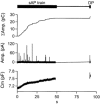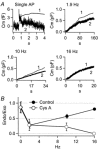Physiological stimuli evoke two forms of endocytosis in bovine chromaffin cells
- PMID: 11744761
- PMCID: PMC2279013
- DOI: 10.1111/j.1469-7793.2001.00871.x
Physiological stimuli evoke two forms of endocytosis in bovine chromaffin cells
Abstract
1. Exocytosis and endocytosis were measured following single, or trains of, simulated action potentials (sAP) in bovine adrenal chromaffin cells. Catecholamine secretion was measured by oxidative amperometry and cell membrane turnover was measured by voltage clamp cell capacitance measurements. 2. The sAPs evoked inward Na(+) and Ca(2+) currents that were statistically identical to those evoked by native action potential waveforms. On average, a single secretory granule underwent fusion following sAP stimulation. An equivalent amount of membrane was then quickly internalised (tau = 560 ms). 3. Stimulation with sAP trains revealed a biphasic relationship between cell firing rate and endocytic activity. At basal stimulus frequencies (single to 0.5 Hz) cells exhibited a robust membrane internalisation that then diminished as firing increased to intermediate levels (1.9 and 6 Hz). However at the higher stimulation rates (10 and 16 Hz) endocytic activity rebounded and was again able to effectively maintain cell surface near pre-stimulus levels. 4. Treatment with cyclosporin A and FK506, inhibitors of the phosphatase calcineurin, left endocytosis characteristics unaltered at the lower basal stimulus levels, but blocked the resurgence in endocytosis seen in control cells at higher sAP frequencies. 5. Based on these findings we propose that, under physiological electrical stimulation, chromaffin cells internalise membrane via two distinct pathways that are separable. One is prevalent at basal stimulus frequencies, is lessened with increased firing, and is insensitive to cyclosporin A and FK506. A second endocytic form is activated by increased firing frequencies, and is selectively blocked by cyclosporin A and FK506.
Figures








Similar articles
-
Compensatory and excess retrieval: two types of endocytosis following single step depolarizations in bovine adrenal chromaffin cells.J Physiol. 1998 Feb 1;506 ( Pt 3)(Pt 3):591-608. doi: 10.1111/j.1469-7793.1998.591bv.x. J Physiol. 1998. PMID: 9503324 Free PMC article.
-
Calcium dependence of action potential-induced endocytosis in chromaffin cells.Pflugers Arch. 2003 Feb;445(5):540-6. doi: 10.1007/s00424-002-0966-y. Epub 2002 Dec 10. Pflugers Arch. 2003. PMID: 12634923
-
Low frequency stimulation of mouse adrenal slices reveals a clathrin-independent, protein kinase C-mediated endocytic mechanism.J Physiol. 2003 Dec 15;553(Pt 3):707-17. doi: 10.1113/jphysiol.2003.053918. Epub 2003 Sep 18. J Physiol. 2003. PMID: 14500763 Free PMC article.
-
How the stimulus defines the dynamics of vesicle pool recruitment, fusion mode, and vesicle recycling in neuroendocrine cells.J Neurochem. 2016 Jun;137(6):867-79. doi: 10.1111/jnc.13565. Epub 2016 May 2. J Neurochem. 2016. PMID: 26849771 Review.
-
Calcium channel types contributing to chromaffin cell excitability, exocytosis and endocytosis.Cell Calcium. 2012 Mar-Apr;51(3-4):321-30. doi: 10.1016/j.ceca.2012.01.005. Epub 2012 Feb 10. Cell Calcium. 2012. PMID: 22317919 Review.
Cited by
-
Dynamin I plays dual roles in the activity-dependent shift in exocytic mode in mouse adrenal chromaffin cells.Arch Biochem Biophys. 2008 Sep 1;477(1):146-54. doi: 10.1016/j.abb.2008.04.039. Epub 2008 May 6. Arch Biochem Biophys. 2008. PMID: 18492483 Free PMC article.
-
Most vesicles in a central nerve terminal participate in recycling.J Neurosci. 2013 May 15;33(20):8820-6. doi: 10.1523/JNEUROSCI.4029-12.2013. J Neurosci. 2013. PMID: 23678124 Free PMC article.
-
Vesicle priming and recruitment by ubMunc13-2 are differentially regulated by calcium and calmodulin.J Neurosci. 2008 Feb 20;28(8):1949-60. doi: 10.1523/JNEUROSCI.5096-07.2008. J Neurosci. 2008. PMID: 18287511 Free PMC article.
-
Massive calcium-activated endocytosis without involvement of classical endocytic proteins.J Gen Physiol. 2011 Jan;137(1):111-32. doi: 10.1085/jgp.201010468. J Gen Physiol. 2011. PMID: 21187336 Free PMC article.
-
The molecular physiology of activity-dependent bulk endocytosis of synaptic vesicles.J Neurochem. 2009 Nov;111(4):901-14. doi: 10.1111/j.1471-4159.2009.06384.x. Epub 2009 Sep 16. J Neurochem. 2009. PMID: 19765184 Free PMC article. Review.
References
-
- Artalejo CR, Elhamdani A, Palfrey HC. Calmodulin is the divalent cation receptor for rapid endocytosis, but not exocytosis, in adrenal chromaffin cells. Neuron. 1996;16:195–205. - PubMed
-
- Artalejo CR, Elhamdani A, Palfrey HC. Secretion: dense-core vesicles can kiss-and-run too. Current Biology. 1998;8:R62–65. - PubMed
-
- Aunis D. Exocytosis in chromaffin cells of the adrenal medulla. International Review of Cytology. 1998;181:213–320. - PubMed
Publication types
MeSH terms
Substances
LinkOut - more resources
Full Text Sources
Miscellaneous

